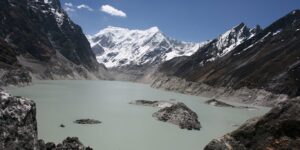GS3 – Disaster Management

Context
A major Glacial Lake Outburst Flood (GLOF) in Nepal has caused severe damage to infrastructure. Given the vulnerability of the Indian Himalayan region to similar risks, India is enhancing its disaster preparedness and cross-border coordination.
What is a GLOF?
GLOFs occur when water from a glacial lake is suddenly released, often due to natural triggers such as avalanches, earthquakes, or landslides, leading to dangerous flooding in downstream regions.
India’s Multi-Layered Response to GLOFs
- Shift Toward Prevention
- Under the leadership of the National Disaster Management Authority (NDMA), India is moving from a reactive relief-based model to a proactive and preventive disaster management approach.
- National GLOF Risk Mitigation Programme
- Budget: $20 million initiative.
- Coverage: Originally 56 glacial lakes, now expanded to 195 lakes, categorised into four risk levels.
- Key Components
- Hazard Mapping: Scientific field assessments to identify high-risk lakes.
- Early Warning Systems: Deployment of Automated Weather and Water Stations (AWWS).
- Structural Measures: Channels for water drawdown and retention structures to manage overflow.
- Advanced Tech Tools:
- SAR Interferometry: To monitor slope stability.
- Electrical Resistivity Tomography (ERT): Detects hidden ice cores under moraine dams.
- Remote Monitoring: Satellite and drone imagery assess lake size, shoreline changes, and water volume.
- Training & Awareness:
- ITBP personnel trained for manual early warnings.
- Community-level drills and sensitisation in vulnerable areas.
Key Challenges
- Data Gaps: Difficult terrain and high-altitude conditions make real-time data collection challenging.
- Climate Change: Record heat years (2023 & 2024) are accelerating glacial melt and increasing water volumes.
- Technology Limitations: Indian innovations are underutilised in real-time monitoring.
- Weak Surveillance: Gaps persist in automated alerts and satellite-based updates.
Way Forward
- Promote Indigenous Tech: Launch a Challenge Fund under Start-up India for rugged, low-cost sensors.
- Mandatory GLOF Assessments: Incorporate GLOF analysis into DPRs of infrastructure projects.
- Cross-Border Collaboration: Develop real-time alert-sharing with Nepal, Bhutan, and China.
- Community-Led Surveillance: Train local volunteers in high-altitude villages to monitor and forecast risks, blending traditional knowledge with scientific tools.




